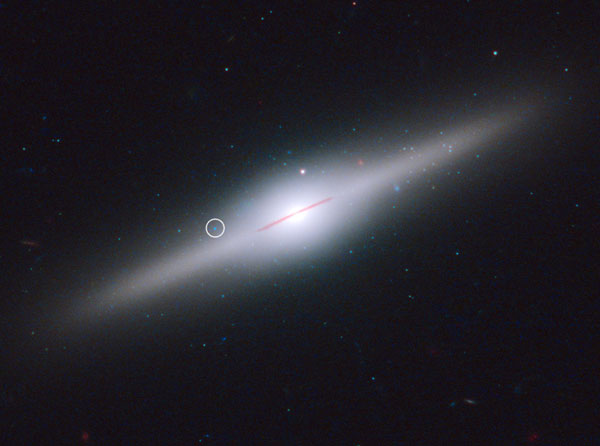Ruins of the early universe
Astronomers have discovered the representative of a new member of the "black hole" family: medium black hole.
After nearly three years of constantly monitoring an extremely bright object less than 300 million light-years from Earth, astronomers have just announced the latest discovery related to the black hole, who was dubbed the giant. brutal and brutal in the universe. Through NASA's Chandra X-ray observatory and SWIFT telescope, experts formally introduced HLX-1, the first representative of the new black hole - mid-range black hole.

Black hole HLX-1 is found inside a star cluster - (Photo: NASA)
Until recently, black holes were mainly classified into two main types, including small black holes, which were several times the mass of the sun; and a supermassive black hole, equipped with gravity of many millions of suns combined. The second type of black hole is so big that it can swallow our solar system in a single tap. Infamous for voracious habits, with the ability to rip and swallow star systems, super-black holes are often in the middle of most galaxies, including the Milky Way.
The new member is determined to be in the middle of two veteran members of the black hole family, with a mass of about 90,000 suns.
In 2009, a team of international experts happened to discover HLX-1. They found that the object continuously spewed abundance of X-rays and radio flares. However, these materials do not come from the core of its spiral galaxy, which came from more than 12,000 light-years ago.'Our observations from 2009 to 2010 show that HLX-1 behaves like black holes, so we continue to look forward to waiting for waves of radio waves from HLX-1, to August. and in September 2011, everything was as expected, 'National Geographic quoted Natalie Webb, head of CESR Astrophysics Laboratory in France.
The origin of these mid-sized black holes may lie in the center of globular clusters, where hundreds of thousands of stars are crowded in tight spaces under the influence of gravity. Besides, not to exclude new members may be the ancient ruins of the universe, formed by early stars, according to the Science report. Webb expert interprets, in the dawn of the universe, massive stars may have appeared, with tens of thousands of times the mass of the sun. However, they have a short lifespan, and at the end of life have become medium-sized black holes.
The existence of a new black hole may play an important role in deciphering why its huge relative was formed. For example, Webb offers a hypothesis that mid-range black holes may be the 'precursors' of super-black holes. These giants can be formed when a medium-sized 'mid-sized' black hole has enough material to balloon to at least 1 million suns; or some medium-sized black holes merged to become a supermassive black hole. Either way, HLX-1 is still the only representative of the medium-sized black hole that has been found for a long time, and it is unclear how widespread these black holes are in the vast universe.
- As early as 2.8 billion years the new universe dies, don't be too afraid
- The bright galaxy takes the scientist to the early universe
- The first time the signal of the oldest stars in the universe was detected
- Detecting huge black holes revealing the universe at the age of cradle
- Unmanned aerial map of Peru ruins
- The most impressive findings about the universe in 2012 (2)
- Troy ruins ruins on the hill of Turkey
- The galaxy cluster is 500 billion billion times heavier than the Sun.
- Discover the oldest galaxy in the universe
- Find the ruins of the mysterious ancient empire in Iraq
- Parallel universe theory is not only math, it is verifiable science
- Candidate of the first galaxy of the universe?
 Van Allen's belt and evidence that the Apollo 11 mission to the Moon was myth
Van Allen's belt and evidence that the Apollo 11 mission to the Moon was myth The levels of civilization in the universe (Kardashev scale)
The levels of civilization in the universe (Kardashev scale) Today Mars, the sun and the Earth are aligned
Today Mars, the sun and the Earth are aligned The Amazon owner announced a secret plan to build a space base for thousands of people
The Amazon owner announced a secret plan to build a space base for thousands of people The nearest black hole discovered is only 150 light years from Earth
The nearest black hole discovered is only 150 light years from Earth  New discovery of the oldest black hole in the universe
New discovery of the oldest black hole in the universe  The Black Pyramid and the tragedy of deep oblivion: A thousand years later, still no escape from the tragedy of tomb raiding
The Black Pyramid and the tragedy of deep oblivion: A thousand years later, still no escape from the tragedy of tomb raiding  Exploring the 'Black Box of the Earth' project: A device that records the process of human extinction
Exploring the 'Black Box of the Earth' project: A device that records the process of human extinction  Finding the mysterious 'monster' that is making the universe expand
Finding the mysterious 'monster' that is making the universe expand  Why do images of black holes appear to be burning from the outside?
Why do images of black holes appear to be burning from the outside? 